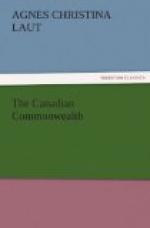He saw the backwash of disappointed gold seekers. He realized the enormous possibilities of free advertising for Canada, and he launched such a campaign of colonization for Canada as the most daring optimist hardly dreamed. Agents were appointed in every hamlet and city and town in the western states—especially those states like Iowa and Illinois and Minnesota and Wisconsin, where land was becoming high priced. The personal testimony of successful farmers was bill-posted from station platform to remotest barb-wire fence. The country was literally combed by Sifton agents. Big land companies which had already exploited colonization schemes in the western states pricked up their ears and sent agents to spy out the land. Those agents may have deluded themselves that they went to Canada secretly; it is a safe wager that Sifton’s agents prodded them to activity at one end and Sifton’s agents caught and piloted and plied them with facts at the other end. I know of land that English colonization companies had failed to sell at fifty cents an acre that was sold at this time to these American companies at five dollars and resold by them at fourteen dollars to thirty dollars.
Such profits are the best advertisement for a propaganda. There followed a land boom compared to which the gold boom had been mild. American settlers came in special cars, in special trains, in relays of special trains. Before Canada had wakened up to it fifty thousand American settlers had trekked across the border. You met them in Peace River. You met them at Athabasca. You met them on far reaches of the Saskatchewan. And land jumped in value from five dollars to fifteen dollars, from fifteen dollars to thirty dollars an acre. When Canada’s yearly immigration reached the proportions of four hundred thousand—half Americans—it is not exaggerating to say the prairie took fire. Villages grew into cities overnight. Edmonton and Calgary and Moose Jaw and Regina—formerly jumping-off places into a no-man’s-land—became metropolitan cities of twenty-five to fifty thousand people. If every American settler averaged fifteen hundred dollars on his person at this period—as customs entries prove—it may be confidently set down that his value as a producer and worker was another fifteen hundred dollars. Wheat exports jumped to over one hundred million dollars a year. Flour mills and elevators financed by western American capital strung across the prairie like beads on a string.




